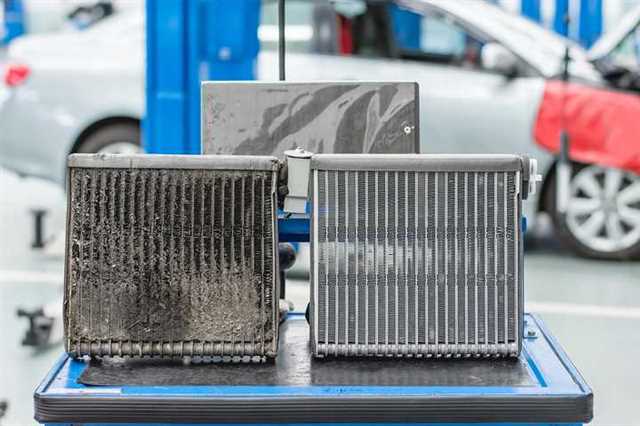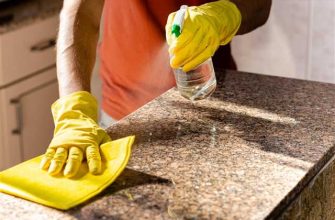
Cleaning your radiator fins is an important step in maintaining the performance and efficiency of your radiator. Over time, radiator fins can become clogged with dust and debris, which can prevent proper airflow and lead to overheating. Fortunately, cleaning the radiator fins is a relatively simple process that can be done with just a few tools and some basic knowledge.
One of the easiest ways to clean radiator fins is to use a foaming radiator fin cleaner. This type of cleaner is specifically designed to dissolve and remove dirt and grime from the fins, allowing for better heat transfer and improved performance. Simply spray the foaming cleaner onto the fins and allow it to sit for a few minutes. Then, use a brush to clean the fins, working in a gentle, circular motion.
If you don’t have a foaming radiator fin cleaner in the house, don’t worry! There are still other methods you can use to clean behind the radiator. One option is to use water. Simply fill a spray bottle with water and spray it onto the fins, then use a brush to clean them. Be sure to use a brush with soft bristles to avoid damaging the fins.
Another option is to use a radiator cleaning brush. This specialized brush is designed to fit between the fins and remove any built-up dust or debris. Simply insert the brush between the fins and gently move it back and forth to dislodge any dirt. You can also use a vacuum cleaner with a soft brush attachment to remove any loose dust or debris.
No matter which method you choose, it’s important to clean your radiator fins regularly to ensure optimal performance. By removing dust and debris from the fins, you can help improve airflow and prevent overheating. So, don’t let your radiator suffer from clogged fins – take the time to clean them and enjoy a cooler and more efficient radiator!
- How to clean a dusty radiator?
- Step 1: Prepare the radiator for cleaning
- Step 2: Remove any obstacles
- Step 3: Use a brush to clean radiator fins
- Step 4: Use a foaming radiator fin cleaner
- Step 5: Clean behind radiators with water
- Step 6: Reassemble and inspect
- What can be used to clean radiator fins?
- Does cleaning radiator fins help improve performance?
- What are radiator fins?
- How to clean radiator fins?
- Can I clean the radiator fins in a car?
- Does cleaning the fins help?
- How to clean radiator fins in a house?
- 1. Gather the necessary tools
- 2. Turn off the radiator
- 3. Remove dust and debris
- 4. Apply radiator fin cleaner spray or foam
- 5. Let the cleaner sit
- 6. Scrub the fins
- 7. Wipe off the cleaner
- 8. Rinse if necessary
- 9. Dry the radiator fins
How to clean a dusty radiator?
If you have a dusty radiator, proper cleaning is essential to enhance its performance and efficiency. Here are some easy steps to clean a dusty radiator:
Step 1: Prepare the radiator for cleaning
Before starting the cleaning process, make sure to turn off the heating system and let the radiator cool down completely. This prevents any accidents or injuries.
Step 2: Remove any obstacles
Clear the area around the radiator from any furniture or objects that may obstruct access to the radiator fins. Dust and dirt tend to accumulate behind radiators, so it’s important to have enough space to clean them properly.
Step 3: Use a brush to clean radiator fins
Start by using a brush specifically designed to clean radiator fins. Gently brush the dust off the fins, moving the brush along the direction of the fins. Be cautious not to bend or damage the delicate fins.
Step 4: Use a foaming radiator fin cleaner
If the brush alone doesn’t remove all the dirt and dust, you can use a foaming radiator fin cleaner spray. Apply the foaming cleaner to the fins, let it sit for a few minutes as per the product’s instructions, and then wipe it off with a clean cloth.
Step 5: Clean behind radiators with water
In some cases, dust and dirt may accumulate behind the radiator, making it difficult to clean with a brush alone. In such situations, you can use water to clean the radiator fins. Use a spray bottle or a damp cloth to gently clean the area behind the radiator.
Step 6: Reassemble and inspect
After the cleaning process, carefully reassemble any parts you may have removed and inspect the radiator to ensure it’s clean and functioning properly.
Cleaning your radiator regularly can significantly improve its performance, enhance energy efficiency, and prolong its lifespan. So, make sure to include radiator cleaning as part of your regular household maintenance chores!
What can be used to clean radiator fins?
When it comes to cleaning radiator fins, there are several options available to you. Let’s take a look at some of the most common methods and tools that you can use:
- Water: Using water is one of the easiest and most effective ways to clean radiator fins. You can use a hose or a pressure washer to spray water on the fins and remove any dust or debris that has accumulated.
- Cleaning brush: A brush specifically designed for cleaning radiator fins can be a great tool to have. These brushes often have soft bristles that can reach between the fins to remove dust and dirt.
- Radiator fin cleaner spray: There are many commercially available sprays that are designed to clean radiator fins. These sprays typically have a foaming action that helps to remove dirt and grime.
If you have a dusty radiator in your house or car, you can use any of these methods to clean the fins. Remember to follow the manufacturer’s instructions when using any cleaning products and to take proper safety precautions.
In some cases, if the radiator fins are heavily clogged or damaged, it may be necessary to seek professional help. A technician can use specialized tools and equipment to clean or repair the radiator fins for optimal performance.
Does cleaning radiator fins help improve performance?
Yes, cleaning radiator fins can significantly improve the performance of a radiator. Radiator fins are responsible for dissipating heat from the coolant inside the radiator, and when they are dusty or dirty, their efficiency decreases. This can lead to reduced cooling performance and potential overheating issues. So, cleaning the radiator fins is essential to maintain optimal performance.
What are radiator fins?
Radiator fins are thin metal pieces that are attached to the tubes of a radiator. They are designed to increase the surface area of the radiator, allowing for better heat transfer. When air passes through the fins, the heat from the coolant is transferred to the air, which helps in cooling down the coolant.
How to clean radiator fins?

There are several methods to clean radiator fins, depending on the level of dirt and the tools you have available. Here are a few common methods:
- Using a radiator fin cleaner spray: Spray the cleaner directly onto the fins and let it sit for a few minutes. Then, use a brush to scrub the fins gently. Rinse thoroughly with water.
- Using a foaming radiator fin cleaner: Apply the foaming cleaner onto the fins and allow it to sit for the recommended time. The foam will loosen the dirt, making it easier to remove. Rinse off the cleaner with water.
- Using a radiator cleaning brush: Gently brush the fins to remove any dust or debris. Be careful not to damage the fins or bend them.
- Using a brush to clean behind radiators: If the fins are difficult to access, you can use a long-handled brush to clean behind the radiator. Dip the brush in water and reach behind the radiator to remove any dirt or dust.
Can I clean the radiator fins in a car?
Yes, you can clean the radiator fins in a car following a similar process as mentioned above. However, it is crucial to use a car radiator fin cleaner specifically designed for automotive radiators. These cleaners are formulated to effectively remove dirt and debris without causing any damage to the radiator fins.
Does cleaning the fins help?
Yes, cleaning the radiator fins can help improve the performance of the radiator. By removing the dust and dirt buildup, the airflow through the fins is restored, allowing for better heat dissipation. This leads to improved cooling performance and prevents overheating issues.
| Method | Advantages | Disadvantages |
|---|---|---|
| Using a radiator fin cleaner spray | Easy to use, removes dirt effectively | May require multiple applications, can be messy |
| Using a foaming radiator fin cleaner | Loosens and removes dirt effectively | May require additional rinsing, can be messy |
| Using a radiator cleaning brush | Gentle on fins, can reach difficult areas | Requires manual scrubbing, may not remove all debris |
| Using a brush to clean behind radiators | Allows cleaning of hard-to-reach areas | May require additional tools, water may leak into the wall |
Overall, regularly cleaning the radiator fins is an important maintenance task to ensure optimal performance and prevent potential issues caused by overheating. Choose a cleaning method that suits your needs and ensure proper rinsing to remove any residue or cleaning agents.
How to clean radiator fins in a house?
Radiator fins in a house can get dusty over time, which can reduce their effectiveness in cooling or heating the room. Cleaning the radiator fins regularly can help maintain their performance and improve energy efficiency. Here are the steps to clean radiator fins in a house:
1. Gather the necessary tools
Before starting the cleaning process, gather the following tools:
- Radiator fin cleaner spray or foaming radiator fin cleaner
- Brush to clean radiator fins
- Microfiber cloth or soft brush
- Water and mild detergent (if necessary)
2. Turn off the radiator
Prior to cleaning, make sure the radiator is turned off and cooled down to avoid burns or accidents.
3. Remove dust and debris
Using a brush, gently remove the loose dust and debris from the radiator fins. You can also use a vacuum cleaner with a brush attachment to get rid of the loose dirt.
4. Apply radiator fin cleaner spray or foam
Apply the radiator fin cleaner spray or foaming radiator fin cleaner according to the manufacturer’s instructions. This will help remove any stubborn dirt or grease that may have accumulated on the fins.
5. Let the cleaner sit
Allow the cleaner to sit on the radiator fins for a few minutes to loosen the dirt and grime.
6. Scrub the fins
Using a brush, gently scrub the radiator fins in a back-and-forth motion. Be careful not to apply too much pressure as this can damage the fins.
7. Wipe off the cleaner
Using a microfiber cloth or a soft brush, wipe off the cleaner from the radiator fins. Make sure to remove all the cleaning solution to prevent any residue from accumulating on the fins.
8. Rinse if necessary
If there is still dirt or residue on the radiator fins, use a mixture of water and mild detergent to rinse the fins. Be careful not to let any water enter the electrical components of the radiator.
9. Dry the radiator fins
After cleaning, allow the radiator fins to dry completely before turning on the radiator again. This will prevent any water from causing damage to the fins or the radiator system.
Regularly cleaning the radiator fins in a house can help maintain their efficiency and improve the overall performance of the radiator. It is recommended to clean the radiator fins at least once a year or as needed, especially if they appear dusty or dirty.








